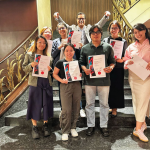
Malls, malls everywhere and according to the IGD — a charity geared at developing initiatives to assist the ever growing food and grocery industry — Asian big box retailers are expected to grow, on average by 3.5% a year between 2016 to 2021.
The projection is encouraging but a little hard to believe, particularly in a time where consumers are taking to their gadgets to buy anything from milk to make up.
In their press statement, Head of Asia Pacific at IGD Nick Miles said the forecast was derived from an analysis of 10 leading large format grocery retailers in the region and identifying a number of challenges and opportunities for this channel to consider over the next few years.
“When the first modern trade retailer broke into the Asian market in the early 1990s with hypermarket and supermarket formats, we expected the traditional trade, largely made up of family-owned grocery chains and small independent stores, to be gradually eliminated. However, 30 years on, traditional trade is still going strong in most of the region and the shape of retail is changing once again,” said Nick.
But does this ring true for Malaysian large format stores too especially when trends of turning digital are at an all-time high?
Founder of Visual EFX Sdn Bhd Sailendra Kanagasundram weighs in on what the future might hold for local big box retailers.
“Competition for a consumer’s wallet is becoming more and more intense [and] the impact of online shopping varies depending on the retail category. I think the biggest hit will be within the areas of hardline consumer products, clothing and electronics where price considerations can be great. Retailers for perishable groceries are still not as highly impacted by online shopping for the simple fact that Malaysian consumers still like to touch and feel their [fresh] products before buying them,” says Sailendra.
“Malaysians [also] still view shopping and window shopping as a means of passing time and relaxing with their families. This will also contribute to the longevity of big box retailers — because they have become part of a lifestyle families here have adopted. I think operators need to take advantage of their unique positioning against their online opponents and push hard.”
The name of the game should ideally be activation strategies for local big box retailers looking to secure their foothold amidst plenty of scepticism from E-commerce advocates.
“Local big box retailers need to innovate to become destination malls. Activation and product engagement can help to differentiate the brick and mortar experience they offer. Experiential shopping — like product demonstrations, cooking experiences and in-store trialling to name a few — helps to engage customers in a way that online might have be in a disadvantageous position to have,” says Sailendra.
Marketing lead at online shopping platform Shopee Rachel Tan takes a less competitor-centric viewpoint on the age-old debate of whether big box retailers may in time succumb to extinction at the expense of their digital counterparts.
“There should not be a competition between the two; instead retail and online platforms should work together to increase brand awareness and sales in the long run. The e-commerce platform can function as the online marketing arm for the retail store, while the retail store can be used as the hub for customers to return or fix the items they purchased online,” says Rachel.
“Local big box retailers should consider an e-commerce platform to retain and increase customer engagement. E-commerce platform should not be considered as a competition, but an online partner instead.”


BEST OF GLOBAL DIGITAL MARKETING Conference 2017
For the seventh year running, we are bringing back the famous Best of Global Digital Marketing Conference to KL with a special focus on Content Marketing this year. Unique case-study based learning, as our team monitors over 200 digital marketing award shows across the globe and interviews the winners. Based on this extensive work, we produce in-depth case studies.
Speakers with digital domain expertise:
• Hando Sinisalu, CEO of Best Marketing International
• Kyoko Yonezawa, Creative Technologist and member of Dentsu Lab Tokyo
• Scott Gray, Experience Director, Mirum South Africa
Global Case Studies include:
BANKING & INSURANCE: Compare The Market, Advocards, Allianz, Ally Bank, Barclays….
TECHNOLOGY & STARTUPS: Hubspot, Pipedrive, MoveHub….
AUTOMOTIVE: Volkswagen, Volvo, Nissan, etc FMCG: Ariel, Unilever, Snickers…
RETAIL: McDonald’s, Harvey Nichols, Zalando….
TRAVEL & TOURISM: Qatar Airways, Transavia, Finland Tourism, Sweden Tourism, KLM…
Each best practice case study is presented based on…
Business problem: What is the market situation? Who are the competitors? What is the target audience? What are the main business/marketing challenges? What are the goals?
Solutions: What are the consumer insights? What was the creative strategy? What was the media strategy? What were the results of the campaign?
Lessons: What other marketers from other countries/other business sectors could learn from this case study? What are the main mistakes to avoid?
The Best of Global Digital Marketing Conference has won popularity in more than 30 cities around the world from Singapore, Moscow, Jakarta, Istanbul to Amsterdam, Johannesburg, Prague, Shanghai, Seoul, etc.
Date: 14 August, 2017 (Thursday)
Venue: Sime Darby Convention Centre, Kuala Lumpur.
Time: 8.30am – 5.00pm
Book your seats early! Call Ruby on 03-77262588 or ruby@adoimagazine.com
MARKETING Magazine is not responsible for the content of external sites.











